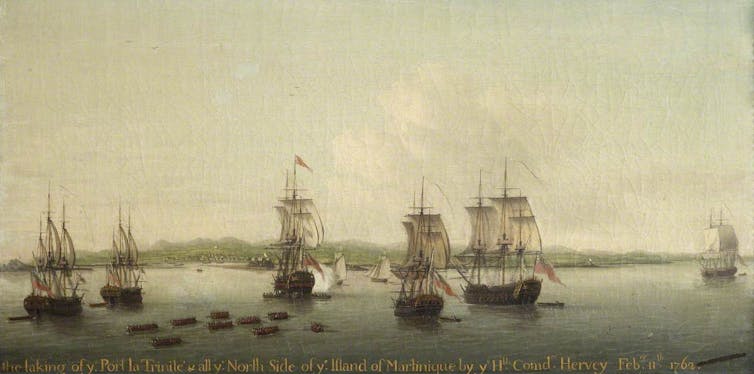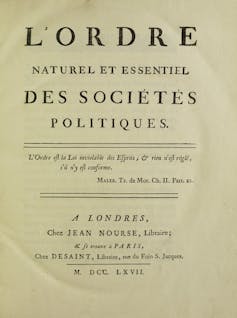How to republish
Read the original article in french and consult terms of republication.
Economic and political reforms: in the footsteps of Paul Pierre Lemercier de la Rivière (1719-1801)
The middle of the 18th century saw the creation of the first true school of economic thought, formed around Doctor François Quesnay (who was notably doctor to the Marquise de Pompadour). Its principal members were Victor Riqueti, marquis de Mirabeau (father of the future revolutionary tribune), Pierre Samuel Du Pont de Nemours, Father Nicolas Baudeau and Paul Pierre Lemercier de la Rivière.
The so-called Economists School, or physiocracy , advocated free trade and political reforms to counter monarchical arbitrariness. It had a marked impact on intellectual spheres and public opinion through its members’ participation in salons and via the press, which enabled it to disseminate its analyses and demands in Éphémérides du citoyen, directed at different times by Baudeau and Du Pont de Nemours.
A lawyer, administrator, consultant and public rights specialist
Most of the group’s members were theorists or popularisers. Lemercier de la Rivière, however, was trained as a lawyer and was the only one with real practical experience. He was successively intendant of the Windward Islands in Polynesia and then of Martinique, captured in 1762 by the English navy during the Seven Years’ War (1756-1763). He participated in and was later the only active member of the Colonial Legislation Committee in the 1780s.
Alongside this experience as an administrator and consultant, he was a public rights lawyer from 1765 to 1792. His intellectual stature was such that he was consulted by royals (Catherine II when she was preparing her Nakaz and Gustave III of Sweden, in 1775, on the subject of public education) and politicians (including Polish deputies for the drafting of a constitution on the eve of the first partitioning of Poland between Austria, Prussia and Russia, alongside FatherGabriel Bonnot de Mably and Jean-Jacques Rousseau. In 1774, he yielded the position of general manager to Anne Robert Jacques Turgot, a sympathiser of the physiocrats, who was appointed in his stead.

Lemercier de la Rivière was above all a talented economic theorist who expounded and developed the Quesnay group’s reflections, which were only disseminated by its leader through short publications that were sometimes difficult to interlink (articles for the l’Encyclopedia by Diderot and d’Alembert and the Éphémérides du citoyen).
In Lemercier de la Rivière, the physiocrats found a public law specialist able to articulate their primary positions in full-length publications, namelyL’Ordre naturel et essentiel des sociétés politiques (1767), and L’Intérêt général de l’État (1770). The former included economic and political analyses while the latter explored the link between market freedoms and ownership rights (which for the physiocrat formed the basis of all society and politics). It was mainly thanks to L’Ordre naturel et essentiel des sociétés politiques that Lemercier de la Rivière became known and attracted the attention of Catherine II and Gustave III. The publication was even praised in the British Isles by the economist and father of classical political economy, Adam Smith.

At the same time, the book sparked controversy and attracted considerable attention from the press and at salons, mainly because its author presented the political aspect of the School using the concept of “legal despotism”, which drew criticism from figures such as Rousseau and Mably. This expression, an oxymoron, was widely rejected, but Lemercier de la Rivière was simply trying to express an idea that was close to his heart: (natural) law must apply to all, including the monarch, and the role of lawyers was to translate it into positive law. Lemercier de la Rivière’s intention was simply to show the need to counter royal arbitrariness by building a true rule of law.
Another position he held dear, namely the idea of combining legislative and executive authority based on the argument that is technically and morally impossible to make laws with neither the power to enforce them nor a public force that is dissociated from the law, was equally strongly criticised. Obviously, this standpoint shocked his contemporaries, acquainted as they were in the recommendations of Charles Louis de Montesquieu on the separation of powers. That said, the two men's analyses concurred on one fundamental point: the judiciary must remain independent.
A “separate branch” of physiocracy
Lemercier de la Rivière continued to publish numerous works in support of the validity of his political positions for the rest of his life, although he abandoned the expression “legal despotism”. In the 1770s, he published two abridged versions of what is considered the physiocratic “doctrine” (De l’Instruction publique and Lettre sur les économistes) and articulated his thinking around a triptych of property, security and liberty. He spent the 1780s working on the codification of colonial laws and regulations for the French Colonial Legislation Committee.
After returning to civil life, he published more works in the months leading up to the Revolution and during the early revolutionary period (1788 and 1789), proposing what he termed a “constitutional framework”. His constitution was accompanied by highly detailed proposals to establish constitutional control through a body of magistrates independent of the king, in a novel approach that was never accepted by the deputies of the revolutionary assemblies.

Toward the end of his life, Lemercier de la Rivière retired to the south of Paris (for the purity of the air) where, disillusioned by the lack of an audience for his work and aware that he would no longer be called upon to hold any post of political responsibility, he decided to put forward his economic and political recommendations to the public one last time.
Like Thomas More's Utopia, he dressed them up in an account describing the social and political customs of the fictional people of Félicie, followed by a section containing a moral and philosophical case for the political organisation of this imaginary kingdom. It was probably this that spared him from retribution during the Reign of Terror.
In his final work, Lemercier de la Rivière often consolidated or supplemented his political positions, distancing himself economically from the physiocracy of his youth: he called for economic freedom combined with selective protectionism and planned production in certain fields that he considered particularly strategic. Nevertheless, he showed himself to be the most political of the physiocrats, hence Turgot’s description of him as a “separate branch” of physiocracy.
His body of work contained the embryonic elements of many analyses that were subsequently developed in economics – often several decades later – such as differential rent (David Ricardo), the multiplier (Richard Kahn and John Maynard Keynes) and economic modelling.
Identity card of the article
| Original title: | Réformes économiques et politiques : sur les traces de Paul Pierre Lemercier de la Rivière (1719-1801) |
| Authors: | Bernard Herencia |
| Publisher: | The Conversation France |
| Collection: | The Conversation France |
| License: | The original version of the article was published in French by The Conversation France under Creative Commons license. Read the original article. An English version was created by Hancock & Hutton for Université Gustave Eiffel and was published by Reflexscience under the same license. |
| Date: | March 20, 2023 |
| Languages: | english and french |
| Keywords: | economic theory, utopia, economic history, the French Revolution |

![[Translate to English:] Licence creative commons BY-SA 4.0 [Translate to English:] Licence creative commons BY-SA 4.0](https://reflexscience.univ-gustave-eiffel.fr/fileadmin/ReflexScience/Accueil/Logos/CCbySA.png)